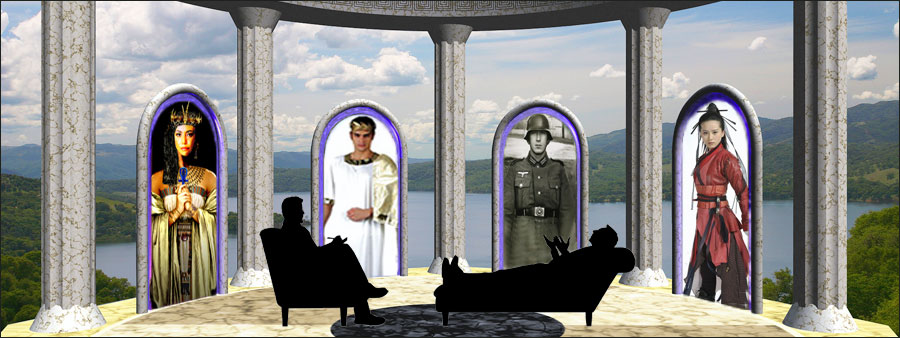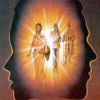Learning From Past Life Therapy
 by Leo Bolduc
by Leo Bolduc
When I was fifteen years old, my brother, Raymond, brought home a five-cent used book, The Search for Bridey Murphy by Morey Bernstein. That book launched my career and provided an avocation which has spanned more than four decades.
In a manner of speaking, I was a pioneer in a new profession, a researcher in a new area of discovery. As a researcher, I designed new methods for others to use. As an author, I compiled the research and published several books on the topic. Later, I became a Board Certified teacher, trainer, and researcher, helping people to improve their lives by healing past trauma and building a better future.
This article highlights some of my learning from forty-four years in past-life therapy. My goal has been, and continues to be, practical application instead of the promotion of theory.
The Continuity of Life
As research continues, we realize that there are amazing connections between the past and the present. People seem to have one life with many (influencing) lifetimes. By experiencing and learning from past-life therapy sessions, one is able to unite the experiences of the various lifetimes into one overall life with one purpose.
Past-life experiences could be explained by comparing them to classes in school. We have many years in school and we learn the lessons appropriate to each level. We also learn from experiences which we have outside the classroom, such as social skills and spiritual values. As a young student, the school years seemed to be disconnected while I was experiencing them; however, in later life, when I began to reflect upon those years, the lessons became clear.
School years represent one segment of the current lifetime. After completing formal schooling, individual learning and experiences vary. Some people join the business world while others choose academic, healing, military, and other careers. Those experiences can be compared to lifetimes within lifetimes.
Imagination
When I work with clients or with large audiences, some people say that, at first, the past-life therapy (PLT) seems like imagination but, soon, the story begins to tell itself. Later, they admit that if they had made up a story, then that would not have been it.
Fear of one’s imagination is a stumbling block to some people because there are not enough identifiable markers to indicate a comfort zone. A first-time experience of PLT (whether as an individual client or in a group) often lacks markers along the way. After a few sessions, the person begins to understand how memory works and the process becomes easier. For some people, memories are very subtle. For others, they can be quite profound with strong impressions and powerful emotions. With time and experience, people begin to appreciate how their memories record, store, and play back experiences (the memory retrieval process).
That five-cent used book changed the focus of my life. Morey Bernstein included little hints of how he conducted the PLT but he did not list specific, sequential procedures. Making a few inferences from his implications, I cut up the book and made a rough, paste-up script.
For over a year, I had been guiding PLT sessions with friends from high school and, then, I wanted to experience a session myself. Using the pasted-up script, my brother, Raymond, guided me through the experience. Soon, I was accessing impressions and deep memories. The information, however, was very subtle. I felt that the memory was from Australia. I was running along a rugged beach strewn with driftwood, scrub brush, and rocks. To my right, there was a wall of reeds and sharp brush with thorns. To my left was the ocean. Within my inner experience, I heard that the reeds were twenty feet tall, an impenetrable wall of reeds and sharp brush. My strongest impression was that I was running for my life.
Although I was receiving valuable information, I started wondering whether it might be fantasy. In that moment of wondering, my mind shifted from the right-brain experiencing of information from memory to the analytical and logical left-brain processing. Sadly, I negated the memory. My logical thinking process said, “You only think that it is Australia because you’ve always wanted to go to Australia.” As a child, I had a big map of Australia on one of my bedroom walls. I felt a connection to the aboriginal people and there seemed to be something in Australia that I had to complete.
For the most part, the left hemisphere of the brain is associated with critical thinking (although there are exceptions, as in the case of hemispherectomy). It is wise and important that we think critically but not when we are doing inspired and creative work. Even though I believed that my impressions were wrong, my left-brain continued to analyze the impression of reeds growing to twenty feet tall. Some years later, I learned that a large section of the Australian coastline is identical to the impressions I received in that session.
I spoke aloud and said to my brother, “Well, you’d better take me out of this because I’m not getting anything.” In reality, I was receiving valuable information and negating it. Foolishly, I dismissed my memory as fantasy. Please learn from my mistake! Hold the analysis until the session of over. It is impossible to re-experience an event and to analyze it at the same time.
When working in one-to-one sessions, it is important to verbalize the impressions. During some sessions, memories can be subtle; in others, they can be very powerful. Verbalize whatever impressions you receive—what you feel, see, hear, or sense in any way. Amazingly, as you start talking, more information will be revealed and the impressions will become more clear. Within a few minutes, the story will begin to tell itself.
If I had started verbalizing the impressions as I received them, then the session would have seemed more successful at the time. By being concerned that the session was only fantasy, I failed to appreciate it. Now, I understand how I process memories and I have learned what NOT to do.
Although everyone processes memories differently, most people (70%) process, primarily, through the visual mode. Other people process memories through hearing or feeling. In my case, I, primarily, felt the impressions that were accompanied by inner, oral communication. I have learned that there are different kinds of imagination. They are: a. Fantasy imagination (as in a Disney cartoon or an animated movie). It might be entertaining and interesting but it is fiction. b. Imagination as a portal to higher thought. It is a doorway to inspiration and enlightenment. c. Constructive imagination as a building block to reality. Everything that humankind has invented or built started as a thought—as creative imagination. The thought grew, as a seed, into reality.
Vivid Recall of Sessions
Many parents cherish bedtime with their children. We surely did. The Edgar Cayce Readings advised parents to utilize bedtime as an effective time to help their children in numerous ways. We would often tell stories and would ask our children to tell stories to us. In order to process experiences, we would ask them to “tell the day”. It was a way for the child to share the experiences and to evaluate the lessons. Sometimes when we told stories, they were designed to contain embedded lessons. Other stories were simply entertaining and had no agendas.
Those children’s stories were cute and interesting but not, necessarily, memorable. In contrast, past-life memories are memorable, meaningful, and valuable. Some parents ask their children to make up their own stories at bedtime—the natural alpha time between being awake and drifting to sleep. Those progressive parents sometimes tape the stories for future reference.
Adults also have memories; however, they are so immersed into the current lifetimes that it takes them a little longer to open to those deep memories. When they are willing to go within themselves, there is a wealth of valuable material for them to appreciate and to learn. Such stories, soul stories, have lasting importance and value.
Whether formal PLT or formal reverie, people remember their sessions vividly decades later. Past-life stories are gifts from long-term memory.
No Famous Personalities
In the many years that I have guided past-life regressions, I have not encountered a famous personality. People relate ordinary lives for the times in which the events occurred.
Comedians, occasionally, joke about reincarnation. Lacking knowledge about the research and the development of the work, they tend to be critical, even harsh, while believing their lines to be funny. They imply that everyone who believes in past lives feels that he or she was a famous personality such as Cleopatra or Julius Caesar. Those personalities existed a couple of millennia ago but finding them today might be difficult.
Typically, in past-life exploration, people relate ordinary lives for the times. Often, they lived average, quiet lives. More valuable than fame is the extent to which they improved their personal growth and spiritual development. What they did to others or for others was of primary importance.
Relevance to Current Issues
Past lives reveal patterns and contain healing lessons. Often, the lessons are themes which connect a number of lifetimes. As stories unfold, the patterns quickly become evident. There are positive patterns and challenging patterns. There are some neutral patterns which are neither good nor bad—just interesting while connecting to a lifestyle. For example, an individual might have had a few lifetimes living near the sea.
Most interesting of all is that, somehow, those soul-stories (lifetimes) are relevant to the person’s current-life issues. Over lifetimes, all things balance. The learning is reflected in the facets of a diamond. Each lifetime reflects a facet or part of a facet, which is a part of the whole.
No Down-side—A Profound Up-side
In the past few decades, the focus of regression work was physical and mental healing. People traveled within themselves to find the origin of their challenging problems. Simply returning to the root cause of the problem did not always bring healing; however, it clarified the areas for the continuing work of self-healing.
The up-side occurs when people rediscover latent skills, talents, and other gifts from past lives. Creative seeds continue to grow in the mind to allow skills and talent to develop in the current lifetime. The planting and harvesting of these gifts can be very valuable. The gifts of the past are also often taken for granted because they come so easily and naturally.
Heal the Past—Build the Future
Although past-life therapy is about exploring the past, the value of the work is in bringing a better today and building for abetter tomorrow. The goal of the work is to study the past while keeping the focus on the present and maintaining a vision for the future. The lessons of the past become integrated with the gifts of the past and their use today will benefit tomorrow. Each soul returns to earth with both challenges and benefits—tasks to perform and inner support to accomplish them. The inner strength becomes recognized and utilized. The overall vision is the oneness of spiritual development.
Life is continuous. Each person has one life with many (influencing) lifetimes. Although the lessons might not be sequential, as we understand sequence, the lifetimes are interconnected in relation to the vision. Generosity, or any attribute, planted in one lifetime might not be harvested until a few lifetimes have passed. People DO harvest what they plant but not always immediately. Perhaps the universe waits for a better payoff.
There is a future in healing the past and an even greater future in rediscovering the gifts of the past. Throughout the past few decades, past life retrieval has grown to become a popular and effective form of therapy. Past life therapy for spiritual development, although relatively recent, grows daily. People everywhere are eager to discover their roots, the foundations of their experiences.
Speaking from experience, I would encourage you to learn to appreciate who you really are as an individual soul and to recognize your patterns over many lifetimes. This understanding will help you to learn your purpose in coming to earth.
Posted in Past Life Therapy, Reincarnationwith comments disabled.





